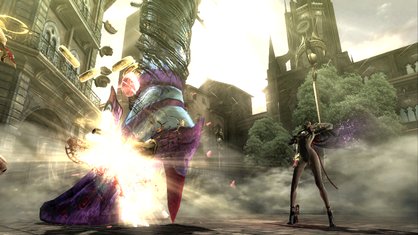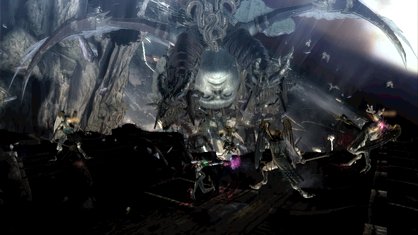As both a character and a game, Bayonetta is all about skipping the foreplay and getting straight to the climax – so we’ll make this quick. She’s a warrior witch who just happens to look like a porno secretary, and whose skin-tight leather catsuit just happens to be made of human hair. Not just any old hair, either, but her own supernatural beehive. Any time she needs to punch above her weight – which, given the size and number of her enemies, is pretty much always – she’ll flick her mane it into the shape of a giant stiletto heel or dragon to deliver a fantastical haymaker. It’s devastating, and not just for its “unfortunate” side-effect of stripping her bare but for a few well-placed locks.

Crazy enough? Let’s move on to her guns: four in total, two in her hands and two strapped to her feet. Their names are Parsley, Sage, Rosemary and Thyme; collectively, they’re called Scarborough Fair. Does she blow holes in the door when tying up her bootlaces? Surely she must. If it sounds like Devil May Cry to the power of infinity, there’s a reason. One of the first games from Japanese “super-group” developer Platinum Games, Bayonetta is the work of Hideki Kamiya, the man behind the original DMC. He’s moved on to other things since, notably Viewtiful Joe and Okami, leaving Dante to fight his own battles. This game, then, could be seen as an alternative take on DMC2: a faster, sexier, more intense version of the first game’s bullet ballet.

Meeting us in Platinum’s offices, Kamiya describes the game’s ferocious style as “climax action.” “Pure action, basically,” he adds, “cutting away anything that doesn’t heighten or enhance the experience. You’ve got all these beautifully rendered environments and exciting scenes, and it’s in the repetition and linking of those that you reach the ‘climax’.” Devil May Cry, he reminds us, started life as a sequel to Resident Evil, and never fully departed from its base of survival horror. Many of its puzzles and much of its exploration were hangovers from a different genre, one that didn’t entirely suit its explosive combat. “I understand the criticism of these ‘rhythm-breaking’ sequences entirely,” he adds, “and much of my team worked on the original DMC, so they understand it too. But this isn’t actually about what worked and what didn’t in DMC, it’s about starting from scratch.
I totally appreciate the value of puzzles: they fill out what might otherwise be a short game. And it’s been difficult getting rid of them. But we don’t want people just looking around. We want to keep them and the game’s tempo moving, moving, moving. If we have the time and resources we’ll come up with the odd puzzle, but we have no intention of breaking flow.”

Besides structure, the difference between Bayonetta and DMC comes down to basic anatomy. With four limbs armed, its heroine simply has more points on the compass from which to attack. Kamiya fires up a level and, as it’s loading, our titular character is doing her thing against a black backdrop on a mirrored floor. She’s a hurricane, striking a different pose each split second, her clacking heels drowned out by the non-stop jangle of spent shell casings. Then the game begins, and any thoughts of ‘epic battle’ are immediately shattered by a game that’s clearly looked at God of War and thought: “Bah. Lightweights.”
The Vestibule is a DMC-style arena battle with the same style of attack waves, the same dynamic tactics, and the same unpredictable formations. But it’s the arena itself that sets it apart: the face of a tumbling clock tower, crashing from the sky through the clouds and down a massive cliff face, whittled to mere fragments as it smashes against the rock. Quite what it was doing up there to begin with is a mystery, but what’s important is the sheer wealth of special effects that swirl and mutate around you. At a glance, the individual character models and textures aren’t quite up there with those of DMC4 – but as a blitzkrieg of action that spans every possible inch of the screen, it’s unlike anything you’ve seen.
Weekly digests, tales from the communities you love, and more


